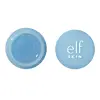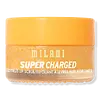What's inside
What's inside
 Key Ingredients
Key Ingredients

 Benefits
Benefits

 Concerns
Concerns

 Ingredients Side-by-side
Ingredients Side-by-side

Triisostearin
Skin ConditioningHydrogenated Polyisobutene
EmollientPolyglyceryl-10 Pentaisostearate
EmollientDextrin Palmitate
EmulsifyingEthylhexylglycerin
Skin ConditioningDiethylhexyl Syringylidenemalonate
Skin ProtectingSqualane
EmollientParfum
MaskingSimethicone
EmollientCaprylic/Capric Triglyceride
MaskingTocopherol
AntioxidantWater
Skin ConditioningRicinus Communis Seed Oil
MaskingGlycerin
HumectantSodium Hyaluronate
HumectantHydrogenated Castor Oil
Emollient1,2-Hexanediol
Skin ConditioningSoluble Collagen
HumectantLinalool
PerfumingGeraniol
PerfumingBenzyl Benzoate
AntimicrobialLimonene
PerfumingCI 77891
Cosmetic ColorantCI 42090
Cosmetic ColorantCI 45410
Cosmetic ColorantTriisostearin, Hydrogenated Polyisobutene, Polyglyceryl-10 Pentaisostearate, Dextrin Palmitate, Ethylhexylglycerin, Diethylhexyl Syringylidenemalonate, Squalane, Parfum, Simethicone, Caprylic/Capric Triglyceride, Tocopherol, Water, Ricinus Communis Seed Oil, Glycerin, Sodium Hyaluronate, Hydrogenated Castor Oil, 1,2-Hexanediol, Soluble Collagen, Linalool, Geraniol, Benzyl Benzoate, Limonene, CI 77891, CI 42090, CI 45410
Sucrose
HumectantHelianthus Annuus Seed Oil
EmollientRicinus Communis Seed Oil
MaskingPolybutene
Helianthus Annuus Seed Wax
Skin ConditioningSilica
AbrasiveDiisostearyl Malate
EmollientArgania Spinosa Kernel Oil
EmollientCocos Nucifera Oil
MaskingRosa Canina Fruit Oil
EmollientSiraitia Grosvenorii Fruit Extract
Skin ConditioningPrunus Amygdalus Dulcis Oil
Skin ConditioningCurcuma Longa Root Extract
MaskingPanax Ginseng Root Extract
EmollientCitrus Reticulata Fruit Extract
Skin ProtectingSynthetic Wax
AbrasiveIsopropyl Titanium Triisostearate
EmollientPhenoxyethanol
PreservativeAroma
Benzyl Benzoate
AntimicrobialCitral
PerfumingLimonene
PerfumingLinalool
PerfumingCinnamal
PerfumingIron Oxides
CI 19140
Cosmetic ColorantSucrose, Helianthus Annuus Seed Oil, Ricinus Communis Seed Oil, Polybutene, Helianthus Annuus Seed Wax, Silica, Diisostearyl Malate, Argania Spinosa Kernel Oil, Cocos Nucifera Oil, Rosa Canina Fruit Oil, Siraitia Grosvenorii Fruit Extract, Prunus Amygdalus Dulcis Oil, Curcuma Longa Root Extract, Panax Ginseng Root Extract, Citrus Reticulata Fruit Extract, Synthetic Wax, Isopropyl Titanium Triisostearate, Phenoxyethanol, Aroma, Benzyl Benzoate, Citral, Limonene, Linalool, Cinnamal, Iron Oxides, CI 19140
 Reviews
Reviews

Ingredients Explained
These ingredients are found in both products.
Ingredients higher up in an ingredient list are typically present in a larger amount.
Benzyl Benzoate is usually created from the condensation of benzoic acid and benzyl alcohol. It is used as a preservative, solvent, and has a floral/balsamic scent in large amounts.
As a preservative, Benzyl Benzoate works against bacteria and fungus. It is often used to treat scabies and lice in medicine.
Solvents are used to keep ingredients together in a product. They can help dissolve ingredients to stable bases or help evenly distribute ingredients throughout the product.
Due to its fragrance, Benzyl Benzoate can be sensitizing and may cause contact dermatitis. It is a known EU allergen. We recommend speaking with a professional if you have any concerns.
Benzyl Benzoate can be naturally found in cranberries and peaches.
Learn more about Benzyl BenzoateLimonene is a fragrance that adds scent and taste to a formulation.
It's found in the peel oil of citrus fruits and other plants such as lavender and eucalyptus. The scent of limonene is generally described as "sweet citrus".
Limonene acts as an antioxidant, meaning it helps neutralize free radicals.
When exposed to air, oxidized limonene may sensitize the skin. Because of this, limonene is often avoided by people with sensitive skin.
The term 'fragrance' is not regulated in many countries. In many cases, it is up to the brand to define this term. For instance, many brands choose to label themselves as "fragrance-free" because they are not using synthetic fragrances. However, their products may still contain ingredients such as essential oils that are considered a fragrance.
Learn more about LimoneneLinalool is a fragrance and helps add scent to products. It's derived from common plants such as cinnamon, mint, citrus, and lavender.
Like Limonene, this ingredient oxidizes when exposed to air. Oxidized linalool can cause allergies and skin sensitivity.
This ingredient has a scent that is floral, spicy tropical, and citrus-like.
Learn more about LinaloolRicinus Communis Seed Oil is the INCI name for castor oil.
Castor Oil helps moisturize the skin. It is rich in a fatty acid called ricinoleic acid. This fatty acid helps prevent moisture loss on the skin. This helps keep your skin soft and hydrated. Ricinoleic acid also has anti-inflammatory and pain reducing properties.
Besides hydrating the skin, castor oil is also used to hydrate hair. By keeping the hair shaft moisturized, breakage is decreased. More studies are needed to show castor oil's effective on stimulating hair growth.
Castor oil is created by cold-pressing castor seeds and then purifying the oil with heat. It was used in Ancient Egypt as fuel in lamps and to help treat eye irritation.
The term 'fragrance' is not regulated in many countries. In many cases, it is up to the brand to define this term. For instance, many brands choose to label themselves as "fragrance-free" because they are not using synthetic fragrances. However, their products may still contain ingredients such as essential oils that are considered a fragrance.
Learn more about Ricinus Communis Seed Oil